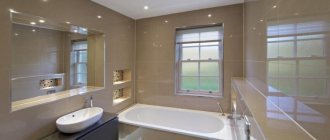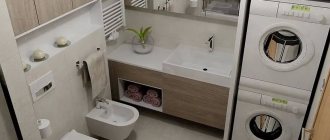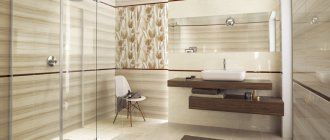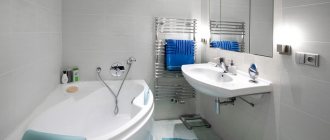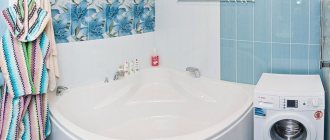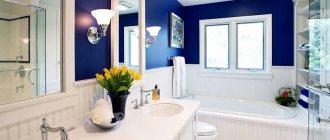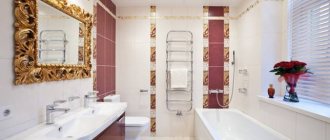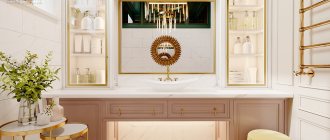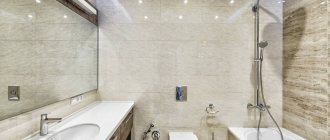Advantages and disadvantages of tiling the bathroom
Advantages of using tiles:
- Long service life. If no mistakes were made when finishing the walls and floor of the room and the tiles are properly cared for during use, then this finishing material will last for a long time. When sanding the cut edges of ceramic tiles, do not forget about the moisture resistance of the selected materials. The components included in sanding mixtures must withstand high humidity conditions.
- Practical to use. Ceramic material is easy to clean and resistant to the use of any antiseptic cleansers.
- Wide range of products to suit every taste. A variety of colors, shapes and sizes of tiles allow you to bring any project to life.
Disadvantages of finishing material:
- Difficult installation technology - surface finishing requires knowledge and skills. Not everyone can install tiles correctly on their own. Because of this, there is a need to find an experienced specialist, whose services are not cheap. The long service life of the finishing material compensates for the money spent on the work.
- The high cost of tiles compared to plastic panels or paint for floors and walls.
- The appearance of the joints between the tiles loses its neatness and beauty over time. The joints between the tiles are treated with a special moisture-resistant material, which darkens a few years after installation or becomes covered with fungus if the necessary surface care is not taken care of.
If cleaning is carried out in a timely manner, the tiles and joints will retain their original appearance for a long time.
Updating walls with decorative elements
This method will allow you to prove yourself as an interior designer. You can decorate with any unexpected things:
- Shells
- Beads
- Stones
- Buttons
- Decorative elements
- And even purchased mosaic tile elements.
Here you can create simply unique decor, as far as your imagination goes. You need to glue it with super glue, acrylic glue or liquid nails. The only drawback of this method is that all the convex parts accumulate dust well, but washing them is not very convenient.
Types of tiles
To arrange the space in the bathroom, the following types of tiles are used:
- Made of ceramics. This material is called tile. Ceramic tiles are considered the most common option for finishing materials. A wide range of tiles and relatively low cost are the advantages of ceramic tiles.
- From mosaic elements. As practice shows, mosaic harmonizes well with ceramic tiles. Bathrooms that combine these types of finishes look unusual. When choosing tiles and mosaics in the same color, you can visually expand the room and make the necessary accents on unusual interior details. Contrasting colors will help draw attention to certain areas in the bathroom. One of the advantages of mosaics is the ability to use this material for cladding bathroom accessories: a beautiful mirror edging, an unusual sink or a bathtub of a non-standard shape.
- From porcelain stoneware. This material has good wear resistance, so the finish will retain its original appearance for a long time. Porcelain tiles will guarantee that no electric charge will pass through it if a washing machine is installed.
- From glass. Tiles will help emphasize the elegance of the interior and create a unique image of the room. When choosing glass tiles, it is important to remember that this material will refresh the room and fill it with coolness. Warm shades of glass tiles will make the room harmonious.
- Made from natural stone. Granite, marble and basalt are used to decorate the bathroom. Using natural stone for finishing is not always possible due to the high cost of the material. Designers propose finishing the walls and floors of bathrooms with artificial stone, which in appearance is very similar to natural stone.
Decoration of the technical room
Designer imagination helps to hide defects and communication structures in the bathroom interior using a universal cladding coating.
In addition, with the right color scheme, you can change not only the appearance, but also the visual atmosphere of the bathroom.
- Dividing the walls in half with light and dark tiles in height is not suitable for a small room.
- Large horizontal stripes of contrasting or similar-colored tiles will visually expand the walls.
- When choosing the texture of ceramic tiles for the toilet room, you must take into account that imitation wood may not be suitable for decorating the interior of any bathroom.
If there is a small source of lighting in the toilet and there are no windows, you should choose the lightest, warmest colors for wall cladding. It is better not to use tiles for laying on the bathroom floor in the form of a bright mosaic pattern, as such a coating will cause uncertainty and distort the shape of the space.
Rules for using tiles
The order of distribution of finishing material on vertical and horizontal surfaces may vary depending on the result that the owner of the room wants to achieve. Designers highlight several options:
- classic layout - the tiles are laid out exactly horizontally, butt-to-butt;
- with offset - the tiles are laid out in even and odd rows, which are offset relative to each other, this placement of the material allows you to imitate brickwork;
- diamond - square tiles are rotated 90º, the seams are diagonal;
- at an angle - the angle of laying the finishing material varies depending on the wishes of the client.
Preferences for a small bathroom
When decorating the interior of rooms with a small area, it is necessary to use design subtleties that will help make the bathroom more spacious.
Finishing in light colors visually enlarges the bathroom and gives the interior sophistication and beauty.
It is important to note that the use of snow-white tiles for cladding the walls and floor of a room is undesirable. The interior of the room will evoke associations with a medical facility. Elegant white tiles are best combined in small bathrooms with other colors:
- blue;
- lilac;
- lavender;
- peach;
- pearly grey.
A competent selection of dark tones will add mystery and depth to the interior. Dark colors do not always negatively affect the perception of small spaces.
Large mirrors and mirror surfaces, which are used for decoration, visually expand the space.
For big
When decorating a spacious bathroom, use any colors that suit the client’s taste.
If you want to focus on a large area of the room, you should choose pastel colors and delicate shades.
If you want the interior of the room to be conducive to privacy and to feel expensive and elegant, then you should consider colors such as dark chocolate and mysterious indigo.
Update groups
Updates are divided into two groups:
- Thorough.
- Superficial.
With a thorough method, the situation completely changes, including combination or vice versa, separation from the toilet. In addition, cabinets, mirrors, decor, etc. are replaced. All this requires large financial costs, which not everyone can afford.
The second option is a budget option, which involves decorating individual sections of the cladding. These can be drawings, stickers, panels and other decoration elements that modernize the design, make it bright and positive.
Worth knowing! Surface renovation does not require large investments, which is why it is most in demand. In addition, this method allows you to update old tiles in the bathroom without replacing them yourself, i.e. with your own hands.
In interior design
Tiles are used to decorate the interior of a bathroom in any style. A huge variety of colors, shapes, sizes, textures of the material allow you to make your wildest dreams come true. Let's look at the interesting interiors of tiled bathrooms in a modern style.
Modern
Art Nouveau style involves the use of bright colors and unusual contrasts in the interior of the room. Suitable for both small and spacious rooms. Such an interior can be budget and very expensive.
Provence
For the interior of a bathroom in the Provence style, discreet pastel colors of ceramic tiles are used. This range will set the bathroom owners in a romantic mood. Sky blue, lavender and soft pink are best. For wall decoration, choose tiles with small floral patterns.
Loft
Designers choose the loft style to decorate spacious rooms. They use ceramic or natural stone tiles in beige and sand tones. Brick color and shades of chocolate are required for use in the interior. Dark brown and terracotta can be the walls and floor of the room, or individual accessories.
Classic
The classic style of bathroom interior will always be popular. Marble tiles are used to decorate it. Finishing materials for a classic interior are high quality and expensive. A successful color scheme is considered to be the choice of calm, soothing shades that will go well with furniture made of expensive wood.
Art Deco
To decorate a bathroom in the Art Deco style, all shades of gray are used. Wall cladding with graphite gray tiles will look beautiful with a black floor. Large floral patterns on the tiles will highlight the elegance of the room. Tiles with an unusual pattern on the floor look very impressive.
Patchwork
A patchwork style interior involves alternating small tiles with each other. These can be tiles of the same color with or without a pattern. Walls lined with small tiles of different colors that combine well with each other look impressive.
High tech
At first glance, the high-tech style may seem impractical for the bathroom. The main principle of wall design in such an interior is the use of glossy surfaces of facing materials. Laying tiles at different angles, using materials of different shapes - all this is a characteristic of the style.
Baroque
A baroque style bathroom can become the highlight of the whole home. The tiles for such a room are chosen in subdued pastel colors. The tiles are laid in the classic version. Exquisite accessories will add luxury to the interior.
Oriental
An oriental-style interior is characterized by peace and tranquility. Natural stone is used to decorate the walls and floors. The tiles are chosen in beige and brown tones. Simplicity and minimalism are the main features of the interior design.
Scandinavian
The Scandinavian interior design trend, which has recently gained popularity, involves the use of harmonious shades of light colors. Ceramic tiles with small patterns go well with wooden elements.
How to combine tiles in a small bathroom
In order for the tiling in the bathroom to look good and correspond to the trend, it is important to know what combinations can be used. There are many variations that will help you create different patterns from one collection of tiles.
Delicate tones with a decorative element Source zonavannoi.ru
The main marble elongated tile will be complemented by pink decor. It is better to lay colored tiles in the middle of the room. This will add a certain emphasis and also help zone the room.
Lilac tiles with mosaic design Source whitelotos.ru
A bathroom with a shower can be tiled with lilac tiles laid horizontally. As an option, such walls can be successfully combined using pixel decoration. The latter masonry can be used for the area behind the shower counter, when decorating the washbasin and small areas of the walls.
Bathroom in coffee tones Source vdome.org
A bathroom in coffee and milk color will turn out to be delicate and unusual. It’s a great idea to alternate dark shades with lighter ones when laying. To get a good effect, designers recommend laying tiles horizontally.
Tile - wood imitation Source ms.decorexpro.com
Wood-effect tiles are perfectly combined with shades, but not textures. You can choose a dark brown tile and dilute it with a light one with a similar pattern (if available). It is allowed to make the lower part of the room dark, including the floor. Starting from the middle, lay light-colored tiles that imitate a log house.
Interesting color combinations Source bg.aviarydecor.com
White classic tiles can be nicely diluted with tiles with a weave structure. For this purpose, cladding models with contrasting shades are selected. If you really need to separate the lower zone from the upper, it is not necessary to use suitable borders. Miniature glass tiles for the bathroom will cope well with this task.
Bathroom with orange tiles and fresh flowers Source klinkerplitka.ru
White marbled tiles with decorative elements Source gratka.pl
Tiles for a classic-style bathroom Source kukupe.ru
Photos in the interior
Examples of tastefully tiled bathrooms.
Design options
Even if you simply update the grout or putty of the tiles in the bathtub, the appearance will change dramatically.
Note!
- Laying quartz vinyl tiles with your own hands step by step: instructions, subtleties, methods, features, installation, “Click-Drop”
- Suspended ceiling Armstrong (125 photos): device, plate sizes, types, installation, calculation and installation
Textured paint for walls: types, how to apply it yourself, instructions, composition, varieties, photos of new designs
There are many ways, but it’s worth paying attention to the simplest and most convenient ones. These include stickers, painting, applying ornaments, drawings, etc.
Pasting process
Before sticking small stickers, slightly visible markings are made with a pencil.
- The paper base, the so-called protection, comes off.
- The adhesive plane is applied to the marked tile.
- Press the sticker and smooth it with a dry material to avoid wrinkles and bubbles.
It will be difficult to update the tiles in a room with a bathroom with large patterned stickers. The process is best carried out with mounting construction film.
- The building material is laid on the floor or other flat surface with the adhesive side up.
- A moisture-resistant film is placed on it with the pattern down and leveled with a soft, dry cloth.
- Next, the protective layer is removed and applied to the planned location on the wall.
- The pattern is pressed carefully so as not to damage the paint of the pattern.
- Then the mounting layer is removed and the sticker is thoroughly smoothed.
Note!
- Do-it-yourself Venetian plaster walls: types, application instructions, photos of beautiful wall decoration, colors
- How to unclog a toilet if it’s clogged: step-by-step instructions, a review of the most effective methods for removing a blockage with your own hands
- Decorating the inside of a balcony: types of materials, design photos, review of the best ideas for interior decoration
Need to know! If air bubbles appear, just prick them with a needle, release the air, pressing them tightly against the tile, and smooth them out.
Closing old cladding
You can use the option of covering the boring tiles with plastic wall panels. The material is quite suitable, as it is resistant to moisture and temperature changes. There is no need to remove the old cladding.
In order for the new coating to firmly adhere to the tile, it is necessary to thoroughly sand the surface, clean and degrease.
Important! When using plastic panels, alcohol should not be used for degreasing, as it can cause harm.
The panels are attached with liquid nails or a special adhesive composition.
Volumetric handmade tile decor
A hand-made panel is an ideal decoration for creating a luxurious design and making the interior unique. Various materials are suitable for work: beautiful pebbles, collected shells, pebbles, beads, river sand, pieces of plastic, etc.
For the base, it is better to use a material that can easily be attached to the cladding with liquid nails or special glue, for example, a plastic panel.
Need to know! The panels should be placed in places where little dust and dirt accumulate, since it is difficult to wash the textured parts.
Applying designs to tiles
Patterns for cladding are selected in accordance with the existing style in the room; for example, for modern design it is appropriate to use geometric shapes or lines. They are easy to spray with a paint aerosol onto a pre-prepared stencil. You can use a regular brush or roller.
The operation scheme is simple:
- Elimination of defects.
- Preparatory work.
- Painting.
- Coating with a protective composition.
Cracks and chips in old tiles are repaired with putty. After it dries, grouting is carried out to make the surface uniform.
The facing surface is prepared in advance: washed and degreased with alcohol or acetone. When using paint for ceramics, there is no need to pre-treat the tiles with special compounds or rub them with sandpaper.
This mixture lays easily on a smooth base. If a different coloring composition is chosen, then preliminary preparation of the surface is indispensable.
Methods of applying patterns:
- Using a working projector, display the image on the wall, outline it and color it.
- Using a grid. Divide the selected picture into squares. Do the same with the wall on which the image will be applied. Then, using the marks, draw pictures from the squares. The main thing is maintaining proportions! The process is not easy, so the work will require care and attention.
- Using adhesive film, organize a stencil, stick it on the cladding and paint it with foam rubber, a brush, or a spray gun. Upon completion of work and drying, remove the film.
Need to know! When applying a design, you can use masking tape, which is great for working with square tiles.
- The drawing can be applied manually if you have experience as a graphic designer or self-confidence.
Recommendations for choosing tiles for a small toilet
To visually expand a modest-sized room, you can use several effective techniques:
- decorate individual zones with mosaics or create panels from them;
- lay tiles diagonally;
- choose facing materials in cool shades;
- use tiles with a mirror surface;
- choose decor of abstract forms.
Very often, when decorating small bathrooms, designers divide the wall with a border horizontally. The shade of the upper part of the wall should be much lighter than the lower one. If you plan to use a decorative border, it is best to place it at eye level.
The optimal size of tiles that are planned to be used to decorate the wall in a small toilet is considered to be 10*10 and 15*15. The smaller the size of the material, the more it will be needed to decorate the room, and the wider the room will look.
Mosaic for bathroom decor ↑
Stores that sell ceramic tiles always have discounted broken tiles on sale. There you can always choose several interesting specimens for making mosaics, which you can use to decorate your bathroom, replacing an expensive border. To do this, perform the following steps:
- Using a marker on the tile, we outline the geometric shapes that will need to be cut out;
- Using a glass cutter and special wire cutters, we cut out the intended elements;
- Using waterproof glue, we attach the tile fragments to a nylon mesh, laying out a pattern invented in advance;
- We attach the made mosaic to the wall using tile adhesive;
- After drying, use colored grout to seal the seams.
Panel on the wall made of broken tiles
